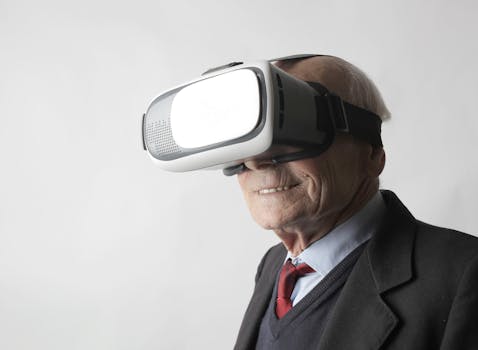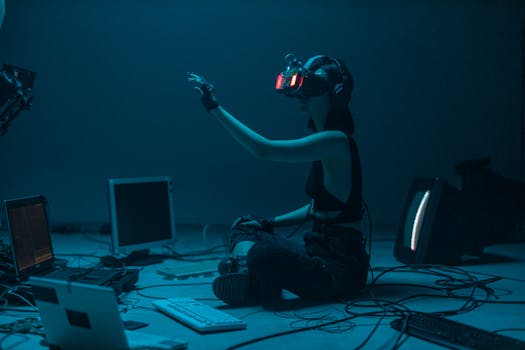Index
- Introduction: Exploring the Concept of the Metaverse
- Definition of the Metaverse: A Shared Virtual Universe
- The Technology Behind the Metaverse: Blockchain, VR, and AR
- Essential Hardware for Entering the Metaverse: VR Headsets and Haptic Devices
- Popular Metaverse Platforms and Their Unique Features
- Creating and Customizing Your Avatar in the Metaverse
- The Metaverse Economy: Cryptocurrencies and NFTs
- Social Interactions and Community Building in the Metaverse
- Entertainment and Gaming in the Virtual World
- Business Opportunities and Virtual Real Estate in the Metaverse
- Challenges and Concerns: Privacy, Security, and Addiction
- The Future of the Metaverse: Predictions and Possibilities
- Conclusion: Embracing the Metaverse Revolution
Introduction: Exploring the Concept of the Metaverse

What is the Metaverse?
The Metaverse is often described as a collective virtual space where digital and physical realities converge. It’s not merely a single platform but a vast network of interconnected virtual environments where users can engage, socialize, and create. In essence, the Metaverse encompasses everything from fully immersive virtual reality experiences to shared online worlds, fostering a sense of presence and interconnectedness among participants.
The Evolution of the Metaverse
The concept of the Metaverse has evolved significantly over the years. Initially popularized by science fiction literature and films, such as Neal Stephenson’s “Snow Crash” or the film “Ready Player One,” the idea has taken root in real-world applications. Today, companies like Meta (formerly Facebook), Microsoft, and Roblox are actively investing in technologies that facilitate the development of the Metaverse, making it more accessible to users worldwide.
Why the Metaverse Matters
Understanding the Metaverse is crucial as it presents new opportunities for social interaction, economic activities, and creative expression. As individuals and businesses increasingly leverage virtual spaces for work, entertainment, and commerce, the Metaverse is poised to reshape industries and influence our daily lives. By exploring this digital frontier, participants can unlock innovative experiences, contribute to new content creation, and build communities that transcend geographical boundaries.
Defining the Metaverse: A Virtual Shared Universe

The Core Concept of the Metaverse
The Metaverse is fundamentally a virtual shared universe that operates in real time and allows for persistent interactions among users. Unlike traditional online platforms that may consist of isolated experiences, the Metaverse provides a continuous digital environment where experiences, assets, and even identities can persist and evolve. This connectedness entails that actions taken in one part of the Metaverse can impact users across different virtual spaces, creating a dynamic ecosystem driven by user engagement.
Key Features of the Metaverse
Central to the Metaverse’s appeal are several key features, including interoperability, user-generated content, and immersive experiences. Interoperability allows users to move seamlessly between various virtual worlds, transferring their avatars, belongings, and experiences. User-generated content enhances the Metaverse’s richness, enabling individuals to create games, art, and other experiences that contribute to a diverse environment. Moreover, the use of virtual reality (VR) and augmented reality (AR) technologies elevates user immersion, making interactions more engaging and life-like.
The Role of Community in the Metaverse
Community plays a vital role in defining the Metaverse. It thrives on collaboration and social interaction, with countless opportunities for individuals to connect, create, and share experiences in shared virtual spaces. Communities in the Metaverse often form around interests such as gaming, art, education, and commerce, fostering a sense of belonging among participants. This social fabric is essential for driving innovation and engagement, as users become co-creators of their digital environments, shaping the evolution of the Metaverse together.
The Technology Behind the Metaverse: Blockchain, VR, and AR

Blockchain: The Backbone of Digital Ownership
Blockchain technology serves as a foundational element in the Metaverse, enabling secure and transparent transactions. By providing a decentralized ledger, blockchain allows users to own, trade, and manage digital assets—ranging from virtual real estate to unique collectibles known as non-fungible tokens (NFTs). This technology not only ensures authenticity and provenance but also empowers users with control over their assets in ways that traditional platforms cannot. As a result, blockchain fosters trust within the Metaverse, encouraging more robust economic activities and allowing users to invest in their virtual identities.
Virtual Reality (VR): Immersion in a Digital Landscape
Virtual reality plays a critical role in creating immersive experiences within the Metaverse. Using VR headsets, users can enter fully realized 3D environments, enhancing their sense of presence and interaction. This technology enables participants to engage in activities as if they were physically present, from virtual gaming to attending events and gatherings. As VR technology continues to advance, it promises to deliver even more lifelike experiences, integrating haptic feedback and advanced visuals that further blur the line between the physical and digital worlds.
Augmented Reality (AR): Blending Digital with the Real World
Augmented reality complements the Metaverse by overlaying digital content onto the real world. Through AR devices like smartphones and smart glasses, users can interact with virtual objects in their physical environment. This technology opens up new avenues for social interaction, gaming, and commerce, driving engagement through seamless experiences that enhance everyday life. For example, AR can facilitate virtual shopping experiences, allowing users to visualize products in their own homes before making a purchase, thereby enriching the connection between the digital and physical realms.
The Future of Technology in the Metaverse
The evolution of technology will significantly shape the Metaverse’s landscape moving forward. Innovations in AI, 5G connectivity, and spatial computing are set to enhance user interactions and experiences. As users demand more realistic and multifaceted engagements, developers will continue to explore how emerging technologies can be integrated into the Metaverse. This advancement will lead to a more inclusive and expansive universe that caters to diverse user needs, paving the way for a truly interconnected digital frontier.
Essential Hardware for Entering the Metaverse: VR Headsets and Haptic Devices

The Role of VR Headsets
Virtual reality (VR) headsets are an essential entry point into the Metaverse, providing immersive experiences that transport users into digitally created worlds. Popular models like the Oculus Quest, HTC Vive, and PlayStation VR incorporate high-resolution displays and motion tracking to enhance the user’s sense of presence. These devices allow users to interact with their surroundings in a 360-degree environment, making activities like gaming, virtual meetings, and socializing feel more realistic. As technology progresses, newer models continue to emerge with improved features such as wireless connectivity and adaptive optics, further enriching the Metaverse experience.
Haptic Devices: Enhancing Touch and Interaction
Haptic devices add another layer of immersion by simulating the sense of touch within the virtual environments of the Metaverse. Controllers equipped with haptic feedback allow users to feel different textures, impacts, and movements, creating a more lifelike interaction with digital objects. Advanced haptic gloves and bodysuits are being developed to track hand movements and body gestures, thereby delivering an unprecedented level of physical engagement. These innovations are particularly valuable in gaming, virtual training, and therapy applications, enabling users to experience a connection to the virtual world that goes beyond sight and sound.
Selecting the Right Hardware for Your Needs
When choosing hardware for the Metaverse, consider factors such as budget, performance, and intended use. Entry-level VR headsets like the Oculus Quest 2 offer affordability and ease of use, making them ideal for casual experiences. In contrast, high-end options like the Valve Index provide advanced graphics and tracking capabilities for serious gamers and developers. Additionally, ensure that your computer or console meets the necessary specifications to support the hardware seamlessly. By carefully selecting the right devices tailored to your preferences, you can enhance your exploration of the Metaverse and enjoy all that it has to offer.
Popular Metaverse Platforms and Their Unique Features

Roblox: User-Generated Worlds
Roblox stands out as a leading platform that empowers users to create and share their own games and experiences. With its robust set of creation tools, anyone can design intricate virtual worlds, allowing for limitless creativity and interaction. This platform also fosters a unique social environment where millions of players interact, attend concerts, and collaborate on projects, making it a vibrant hub for both gamers and developers. The integration of an in-game economy using the Robux currency allows users to purchase items and experiences, enhancing the overall engagement.
Decentraland: Blockchain-Based Virtual Real Estate
Decentraland offers a decentralized ecosystem where users can buy, sell, and trade virtual real estate using cryptocurrency. Built on the Ethereum blockchain, it allows users to construct and monetize their own experiences, leading to a truly user-driven world. Property ownership on Decentraland is confirmed through NFTs, ensuring that each piece of virtual land is rare and unique. Users can host events, create interactive content, and even run businesses, contributing to a flourishing virtual economy where creativity can thrive.
VRChat: Social Interaction in Virtual Spaces
VRChat is a popular platform known for its emphasis on social interaction within virtual reality. Users can create custom avatars and join various immersive environments where they can meet others, play games, and socialize. This platform encourages creativity through user-generated content, where participants can design their own worlds and experiences. VRChat’s versatility and engaging community make it a favorite among those looking to interact and connect, providing a space where friendships can blossom beyond physical boundaries.
Fortnite: Beyond Gaming
While Fortnite is primarily known as a battle royale game, it has expanded into a metaverse platform through its live events and creative experiences. The introduction of in-game concerts and collaborations with major brands allows players to attend events without leaving the game. The Creative mode enables users to build their own experiences, adding further to the game’s versatility. By blurring the lines between gaming and socializing, Fortnite creates a dynamic space where players can not only compete but also come together to enjoy unique cultural experiences.
Creating and Customizing Your Metaverse Avatar
Understanding the Importance of Avatars
Avatars serve as digital representations of users in the Metaverse, acting as their alter egos in various virtual worlds. They allow individuals to showcase their personalities, preferences, and creativity in ways that transcend the limitations of real-world appearances. The ability to customize avatars enhances user engagement, providing a means of expression that cultivates a sense of belonging and identity within the Metaverse community. Avatars can range from realistic depictions to fantastical creations, promoting diversity and individual expression in this expansive digital realm.
Steps to Create Your Avatar
Creating an avatar typically involves several steps, starting with selecting a platform that offers avatar customization tools. Most platforms, such as VRChat, Roblox, and Decentraland, provide intuitive interfaces for designing avatars. Users can choose from various body types, facial features, hairstyles, outfits, and accessories. Advanced features may allow users to adjust their avatars’ animations and expressions, further enhancing personalization. Once created, users can save their avatars, ensuring they can engage in the Metaverse with their unique representation every time.
Customizing Your Avatar: Tools and Tips
Customization tools vary by platform but often include drag-and-drop features, color pickers, and pre-made templates to simplify the avatar creation process. To enhance personalization, consider using unique elements such as clothing items, skins, and accessories that reflect your style or interests. Platforms also frequently host virtual marketplaces where users can purchase or trade customization items. Collaborating with creative communities, engaging in events, and exploring user-generated content can inspire new ideas for avatar designs and ensure that your virtual presence truly stands out in the Metaverse.
The Metaverse Economy: Cryptocurrencies and NFTs

The Rise of Cryptocurrencies in the Metaverse
The Metaverse economy is heavily influenced by cryptocurrencies, which provide a decentralized method for transactions within virtual environments. These digital currencies, like Bitcoin and Ethereum, serve as a foundation for many metaverse platforms, enabling users to buy, sell, and trade various virtual assets securely. The rise of platforms such as Decentraland and Axie Infinity has popularized the use of specific cryptocurrencies, like MANA and AXS, respectively. These tokens not only facilitate transactions but also empower users to participate in governance and community decisions, thereby enhancing the overall user experience and value within the Metaverse.
NFTs: Redefining Digital Ownership
Non-fungible tokens (NFTs) have emerged as a significant aspect of the Metaverse economy, representing unique digital assets secured on a blockchain. Unlike cryptocurrencies, which are interchangeable, NFTs are one-of-a-kind tokens that can signify ownership of digital art, virtual real estate, or in-game items. Platforms like OpenSea and Rarible allow users to trade NFTs, creating a thriving marketplace where creators can monetize their work. This novel approach to ownership is revolutionizing how we perceive value in the digital world and fostering opportunities for artists and game developers to reach broader audiences.
The Impact of Virtual Economies on Real-World Markets
The Metaverse economy presents an intersection between virtual and real-world markets, leading to significant economic implications. As users spend real money on digital goods, virtual economies are beginning to influence financial trends outside the Metaverse. Companies are exploring ways to integrate their products into these virtual spaces, opening new revenue streams through advertising, sponsorships, and digital merchandise. This evolving ecosystem raises questions about regulation, economic sustainability, and the future of work, as virtual jobs and enterprises gain traction. The growth of the Metaverse economy is reshaping not only how we interact online but also how we perceive and participate in economic activities in our daily lives.
Social Interactions and Community Building in the Metaverse

The Essence of Social Connections
Social interactions within the Metaverse are vital to creating a vibrant community. Users engage in diverse activities such as gaming, attending virtual events, and participating in educational workshops, fostering a sense of connection that transcends geographic limitations. Platforms like VRChat and Roblox facilitate these interactions, providing environments where users can form friendships, collaborate on projects, and share experiences. The ability to customize avatars enables individuals to express their personalities, making interactions more relatable and meaningful.
Building Communities: Shared Interests and Goals
Communities in the Metaverse often form around shared interests and goals, creating a rich tapestry of interconnected users. Gamers may unite in specific servers for competitive play, while artists might gather in virtual galleries to showcase their work. This sense of belonging encourages collaboration, leading to the creation of unique content that enhances the overall experience for all participants. Many platforms incorporate features like community forums, event calendars, and social media integrations, further supporting the development of engaged and active groups.
Challenges and Opportunities in Virtual Socialization
While the Metaverse offers immense opportunities for social interaction, it also presents certain challenges. Issues such as moderation, cyberbullying, and the digital divide can impact users’ experiences. Effective moderation and community management are essential to ensure safe and inclusive environments for all participants. As technologies and policies evolve, the Metaverse must adapt to create equitable spaces where diverse voices and backgrounds can thrive. By addressing these challenges, the Metaverse can harness the full potential of social interactions, leading to enriched community building and user engagement.
Entertainment and Gaming in the Virtual World
The Expanding Landscape of Gaming in the Metaverse
The Metaverse has revolutionized the gaming industry, offering players immersive experiences that push the boundaries of traditional gaming. Games within the Metaverse are not limited to linear narratives; they incorporate social interactions, user-generated content, and expansive worlds. Titles like Fortnite and Roblox exemplify this shift, allowing players not only to compete but also to co-create environments and experiences. The integration of live events such as concerts and competitions within these platforms fosters a community-driven atmosphere where players can gather and celebrate their shared interests, enriching the gaming experience beyond just gameplay.
Content creation and streaming have flourished within the Metaverse, as platforms like Twitch and YouTube enable gamers to share their experiences in real time. Streamers and content creators enhance the community by providing live commentary, tutorials, and engaging entertainment, drawing audiences into the expansive world of gaming. The rise of virtual events, including eSports tournaments, showcases professional players competing in the Metaverse, attracting massive viewership and sponsorship opportunities. This interaction between players and audiences creates a dynamic ecosystem where entertainment and social engagement coexist harmoniously.
The Future of Entertainment: Evolving Experiences
As technology evolves, the future of entertainment in the Metaverse will likely include even more diverse and immersive experiences. Innovations in virtual reality (VR) and augmented reality (AR) will contribute to enhanced storytelling, providing users with multi-layered narratives that they can physically inhabit. From interactive films that blend gaming mechanics with cinematic elements to fully immersive themed worlds, the potential for creativity is boundless. The ongoing development of AI-driven content will also personalize entertainment, tailoring experiences to individual preferences and responses. As boundaries continue to blur between social interaction, gaming, and entertainment, the Metaverse will emerge as a leading medium for participatory experiences that redefine how users engage with digital content.
Business Opportunities and Virtual Real Estate in the Metaverse
Virtual Real Estate: A New Frontier for Investment
As the Metaverse continues to grow, virtual real estate has become an intriguing investment opportunity. Users can purchase, sell, or lease virtual plots of land on various platforms like Decentraland and Sandbox. These parcels of land can host events, businesses, or social gatherings, creating passive income streams for landlords. The appreciation of virtual properties has drawn comparisons to the early days of the internet, where digital real estate was often overlooked but later skyrocketed in value. Investors are keen to stake their claims early, as prime virtual locations can become highly sought after, leading to significant returns on investment.
Creating Businesses in the Metaverse
The Metaverse offers a wealth of opportunities for entrepreneurs looking to establish virtual businesses. From virtual storefronts that sell digital goods to entirely immersive experiences, the options are vast. Popular endeavors include hosting virtual events, creating art galleries, or offering gaming experiences, all within a digital ecosystem. Additionally, brands are exploring collaborations with gaming platforms to reach younger audiences through innovative marketing strategies. Companies like Nike and Gucci have already dipped their toes into the Metaverse, launching digital fashion lines and exclusive in-game items, illustrating that integrating commerce into virtual spaces is a growing trend.
Challenges and Strategies for Success
While the potential for business growth in the Metaverse is enticing, it doesn’t come without challenges. Market volatility, user engagement, and technological limitations can impact success. To succeed, businesses need to craft engaging experiences that resonate with their target audience, leveraging community-building and social interaction as key components of their strategies. Utilizing unique marketing tactics and creating high-quality, user-generated content can enhance brand visibility and attract mobile users. As the Metaverse evolves, businesses must remain adaptable, continuously innovating and redefining their presence to thrive in this ever-changing digital landscape.
Challenges and Concerns: Privacy, Security, and Addiction

Privacy Issues in the Metaverse
As the Metaverse continues to integrate into daily life, concerns around user privacy have become increasingly prominent. The collection of vast amounts of personal data by various platforms raises significant questions about how this information is used, stored, and shared. Users often engage in immersive experiences that could inadvertently expose them to data breaches and unauthorized surveillance. The challenge lies in finding a balance between enhancing user experiences through personalization and protecting individual rights to privacy. As developers work to create secure environments, it is essential to implement robust data protection measures and transparent user agreements to build trust within the Metaverse.
Security Risks and Cyber Threats
Security is another critical area of concern as the Metaverse expands. With the use of blockchain and cryptocurrencies comes the risk of hacking and fraud. Cybersecurity threats can lead to compromised accounts, stolen digital assets, and financial losses for users engaged in virtual economies. Moreover, the anonymity offered in virtual environments can facilitate harassment and abusive behavior, complicating security protocols. Platforms must prioritize developing effective security measures, such as two-factor authentication and anti-fraud systems, while also promoting a culture of respect and safety among users to mitigate these risks.
Problematic Use and Addiction
The immersive nature of the Metaverse can lead to problematic use and potential addiction for some individuals. The engaging environments and social interactions can create an escape from reality, making it challenging for users to find a balance between their virtual and real lives. This phenomenon raises concerns about mental health, with excessive use having the potential to lead to social isolation and a decline in well-being. To address this challenge, it is crucial for users to establish healthy boundaries regarding their time spent in the Metaverse and for platforms to promote awareness about responsible use. Features such as usage tracking and self-care resources could assist users in navigating their engagement with these digital landscapes healthily.
The Future of the Metaverse: Predictions and Possibilities
Trends Shaping the Metaverse
As technology continues to advance, several key trends are expected to shape the future of the Metaverse. The convergence of artificial intelligence (AI) with virtual environments will lead to more responsive and interactive experiences. AI-driven NPCs (non-player characters) will enhance gaming and social interactions, making virtual worlds feel more alive. Furthermore, the integration of 5G technology will enable smoother connectivity and high-quality graphics, allowing for more immersive and expansive experiences. As users demand richer interactions, platforms will explore utilizing virtual and augmented reality technologies to create seamless transitions between digital and physical spaces, creating a hybrid environment that enhances everyday life.
Economics of the Metaverse: New Models and Opportunities
The economic landscape of the Metaverse is anticipated to evolve dramatically, opening new avenues for creators and entrepreneurs. The rise of decentralized finance (DeFi) could lead to innovative funding models for virtual projects, enabling creators to finance their work through community-driven initiatives. Moreover, the continued growth of NFTs will redefine ownership and value attribution to digital assets, as artists and developers can set royalties on secondary sales, ensuring they benefit from future transactions. Virtual real estate will remain a hot commodity, with a projected increase in demand for well-located or unique digital properties, thus making land ownership a strategic investment. This transformation is expected to revolutionize how people work, socialize, and engage with digital content.
The Role of User Engagement in the Metaverse’s Evolution
User engagement is crucial for the Metaverse’s future, as communities play a pivotal role in shaping experiences and innovations. Platforms that prioritize community feedback and involvement will likely thrive, as users contribute ideas and creations that enhance collective engagement. The development of collaborative spaces where users can co-create content will foster a sense of ownership and belonging, further driving participation. Additionally, as the Metaverse grows, the focus on diversity and inclusivity will be essential to ensure all voices are heard, crafting an environment where varied experiences enrich the overall ecosystem. By embracing community-driven initiatives, the Metaverse will evolve into a more vibrant and dynamic space that reflects the diverse tapestry of its users.
Conclusion: Embracing the Metaverse Revolution
The Call to Action for Users
As we stand on the brink of the Metaverse revolution, individuals are encouraged to actively participate and explore this digital frontier. The Metaverse offers unique opportunities for social interaction, entrepreneurship, and creative expression that can significantly enhance our lives. By engaging with platforms and technologies that foster connection, collaboration, and innovation, users can shape the future of the Metaverse while enjoying its multifaceted offerings. Embracing this novel digital landscape invites everyone to not only witness the transformation but to contribute to its evolution.
Future Implications for Technology and Society
The development of the Metaverse has profound implications for technology and societal interaction. As this virtual ecosystem grows, it will likely influence various sectors, including education, entertainment, and commerce, making them more immersive and interconnected. Users will benefit from richer experiences that combine learning, work, and play in ways previously unimagined. Moreover, the ongoing integration of cutting-edge technologies such as AI and blockchain will redefine digital ethics, privacy, and community governance, prompting discussions about the rights and responsibilities associated with our digital identities.
The Importance of Ethical Considerations
Navigating the Metaverse requires a thoughtful approach to ethical considerations, including privacy, security, and inclusivity. As participants in this expansive virtual environment, we have a shared responsibility to advocate for safer spaces that promote diverse voices and equitable access. Initiatives aimed at establishing guidelines for respectful interaction, data protection, and community well-being will be paramount. By actively engaging in these discussions and advocating for responsible practices, users can ensure that the Metaverse becomes a positive and empowering space where creativity and collaboration flourish for all.




